Long before purple became trendy as Pantone’s color of the year, I had a thing for purple plants in particular. Two of my favorites are purple fountain grass and Persian shield. One look at those iridescent purple leaves and it’s not hard to see why!
Persian shields (Strobilanthes dyerianus) are such stunners — providing color and interest all year round — that I love having them in my garden. Instead of buying new plants each year (because they’re annuals in my zone), I propagate cuttings in early spring from the one plant I bought a few years ago.
Meet Stella. This plant stays indoors all year and I use its cuttings to grow new plants for outdoor containers and to share with friends and family. For this crazy plant lady, there’s no better win than saving money and getting new plants! Here’s how:
Step 1: Cut a 2-3″ piece from the tip of a branch above a leaf node.
When I first researched how to propagate Persian shield, I came across several articles instructing to cut just below a leaf node. Based on my own trial and error, however, I have found the best response — for both the plant and cutting — to be directly above a node.
The cutting will start to root at the cut location and each node submerged in water. Meanwhile, the plant will grow fuller with two new leaves at the pruned location.
When I followed the Internet’s instructions and cut just below a node, the cutting rooted fine but the stem of the plant was stunted and failed to continue growing. The good news is that most plants are quite forgiving. If you find that you’ve cut the wrong spot and created a stub, you can usually fix it by cutting lower down the stem in the right one.
Step 2: Remove all leaves from the bottom of stems and place in water.
Instead of planting cuttings directly into soil, peat or sand, I place them in water until roots form. I skip rooting hormone and just place the cuttings near a sunny, warm window. Be sure to change the water regularly, every 2-3 days, and roots will begin to appear in about a week.
Step 3: Transfer to soil.
When the roots are about a 1/2–1″ long, I (do a little happy dance and) place these tender babes in small pots of soil to strengthen and grow.
Make sure the pot has drainage holes and then fill it with potting mix about an inch below the rim. Poke a hole in the soil with your finger and push a cutting into the hole, firming the soil around the stem. Once all the cuttings are planted, give the pot a nice drink, let it drain and place it back in the sunny window. Continue watering as needed to keep the soil moist.
Step 4: Plant outdoors.
Once the Persian shield cuttings have outgrown the little pots and the risk of frost has passed, they can be planted outdoors in containers or directly in the ground. They’ll experience some shock when sent outdoors, but given time, they’ll acclimate and grow just fine.
Here’s one cozied up with purple fountain grass, pink pentas and lime green sweet potato vine. (Learn more about planting outdoor containers here.)
Though Persian shield can tolerate sun, it’s best to provide some shade to maintain its vibrant foliage.
Now that you know how to grow Persian shield for free, go forth and propagate!
Thanks for reading! — v.
I’d love to know…
What are some of your must-have flowers and foliage for the garden?
Please share in the comments below.
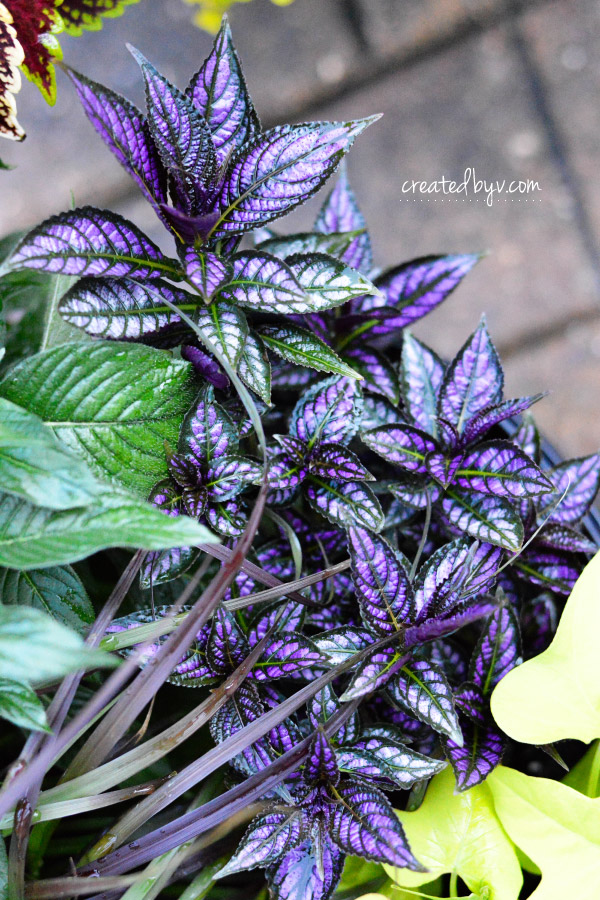
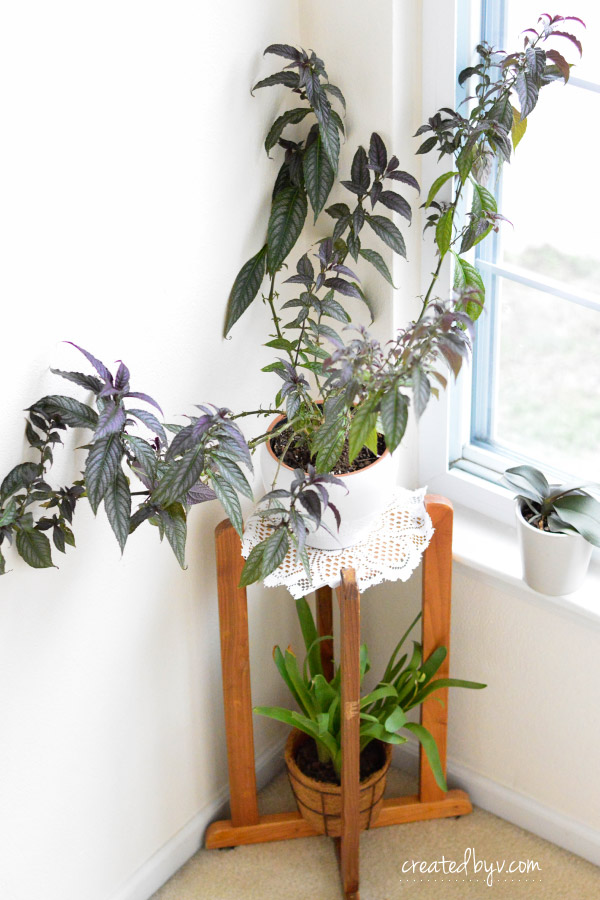
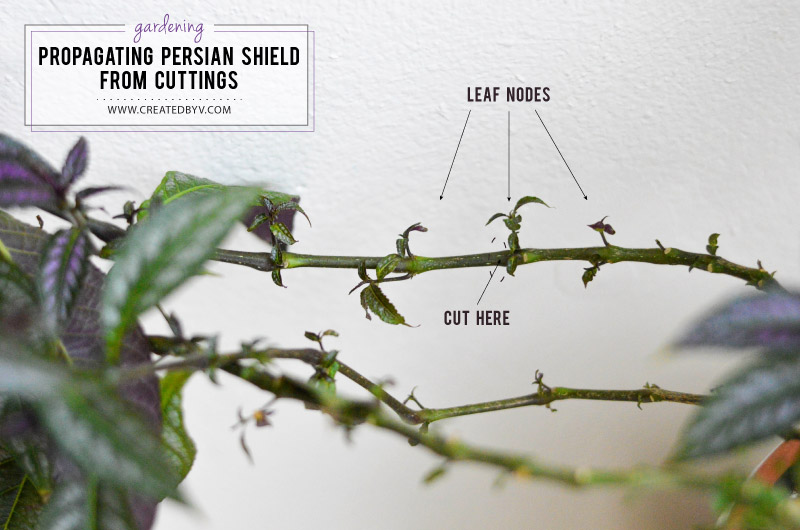
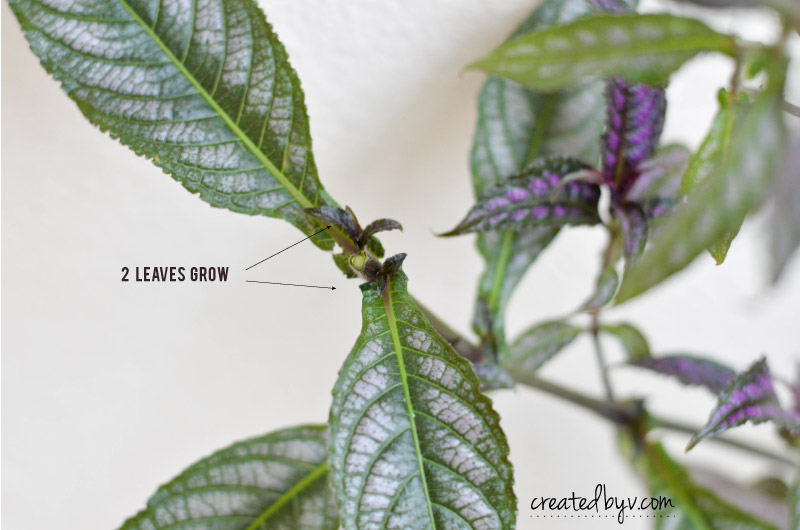

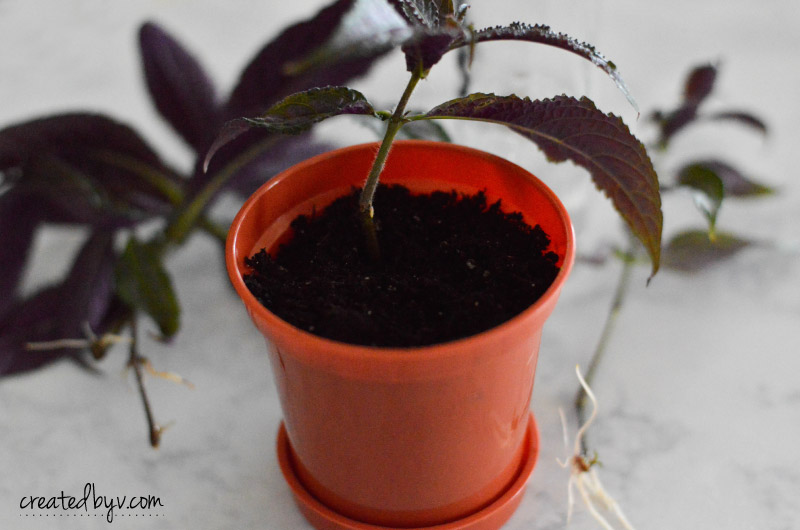
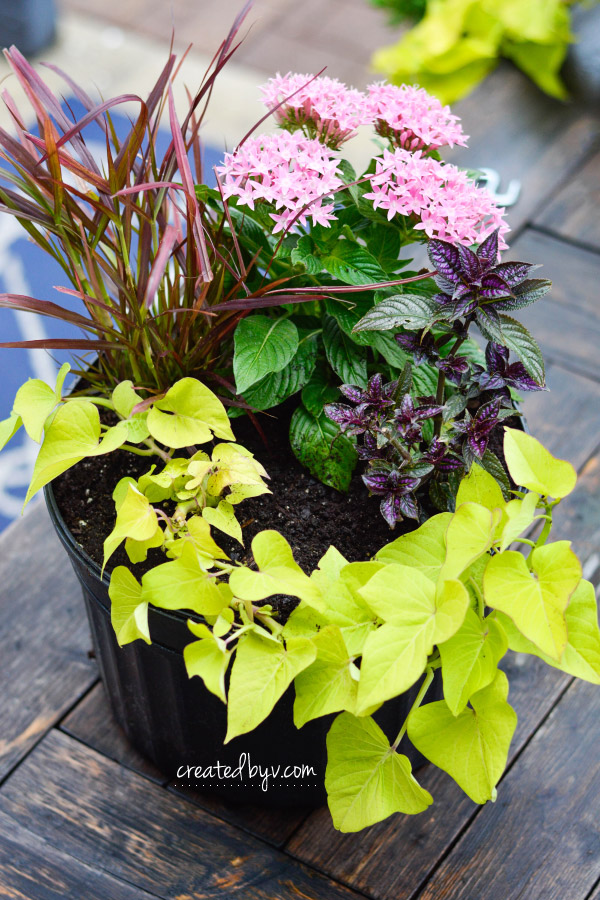

Can you snip off the old tops after placing the rooted cutting in soil. I have kept them in water for awhile and preparing to place outside again. I do have a good node near the soil. Thanks
Once it’s established in soil, you can pinch the tops to create a bushier, fuller plant. Happy growing!
I live in Louisiana just outside of Baton Rouge . Do these purple shield plants survive our winters? We fo hit 32 and 31 degrees but nit real often. Mostly stay ‘s above freezing. If you live in Texas you know what I’m talking about in relation to the weather. I just wondered if they last through the winter or do I have to buy more in the spring and replant?
Thank you,
Cindy Hearld
Thank you for the tips! We have a Persian shield that came in a planter with several other plants- they have gone, but it has survived! We brought it indoors, and unfortunately it has gotten really tall! I just cut back some of the larger stems to see if I can grow from the cuttings. One thing I noticed is that our leaves aren’t very vibrant – and they tend to turn pink, then brown around the edges. Is that too much sun? It’s in a window that does get sunlight, but not really direct. Thank you!
Alex, I found that my plant started to fade in color when I first brought it home. I’d assumed that it wanted partial sun but have since learned that it prefers full, direct sun. I moved it right up front in a south facing window and it took off and got deep purple and shiny again within a week. I’ve only had it a few months and it already wants a larger pot. My advice: put it in full sun and let it shine, buddy.
Since I live in East Texas it is very hot and humid in the summer (zone 8), so I use a lot of blues, purples, and white to cool things off visually….of course, I also compliment with some orange and yellow.
Thank you for the detailed instructions on propagating Persian Shield. I will be so excited if I get some good plants for my friends and family.
Hi there,
Thank you so much for providing such a detailed page on Persian Shields. And I especially appreciate the photos that you’ve added. I bought one about 2 months ago, and it has started legging. I’m considering cutting it at the node and propagating using your suggestions. I’ve a question though. Once (and if) it does grow roots, is it alright to place it I’m the original pot (and not a different, smaller one)? I’m trying to get my plant to look more dense and bushy.
Any help would be much appreciated by my plant and me!
Priya
I’ve tried the water method a number of times and as soon as I transfer to soil they die — within 30 minutes all the leaves are wilted I’ve tried various soils all the same result. I found that even a teaspoon of soil or sand introduced to the water will have the same result. Tried root hormone and had a little better results. I now put the cuttings directly into soil and keep it moist — haven’t had a failure this way.
Any other tips on transferring rooted cuttings to their first pot of soil?
This is where my cuttings die every time.
I don’t have any issues getting them to root in water. But the next step of transferring them to a pot is where I’m stuck.
Cuttings that have sat in water for a long period of time seem to have a slower uptick when placed in soil. My sweet potato vine is one that I place in vases at the end of fall and don’t plant into soil until early spring. They are more finicky about growing in soil — and I lose some — but eventually they take off. I keep the pots in a sunny window and water once a day. When the plants start to sprout new leaves and are sturdier — roots are more established and you can’t just pull it out of the soil — I plant them outdoors as long as the temperatures are above 50 degrees F at night. I really hope you’re able to grow new Persian shields, Jonathan! Keep me posted!
So if I have some cuttings that have an inch or two of new roots in glass jars of water, should I slowly introduce soil into the jars? Or do you transfer them directly into small pots of only soil?
You’ll want to transfer the rooted cuttings directly into pots of soil. Don’t let them dry out between waterings, but don’t overwater them either. Once they are established in the soil indoors, you can transfer them outdoors.I use cuttings both indoors as house plants and outdoor in my flower gardens. The cuttings, once established, also make great gifts. Hope you’re having lots of success this season, Jonathan!
Hello! I know this is an older post but I just want to thank you!! I knew what a node was but nowhere else on the web could I find what one looked like on a Persian Shield! I was afraid not cutting at the exact spot would be a problem & so far it has. The only one I got to propagate was actually cut at the Petiole but it died soon after rooting. One cutting is still alive but I cut it below the node & it hasn’t rooted in 2 weeks. I’m going to try your method next!
I’ve learned from trial and error, and this method has always worked for me. I hope you have just as much success and beautiful shields to enjoy, Liz!
I just tried this and my leaves are all wilting, am I missing something or is this normal? Is the spot TOO sunny? 🤔
It might be a too sunny/hot location, but it’s also very normal for the leaves to wilt and fall off. The good news is they will grow back full and beautiful once you root them in water and then plant them in soil. Hang in there!
Thank you for this article; I just bought my first Persian Shield and and look forward to growing many other plants out of this one!
Yay! The cuttings grow even more beautiful than my original plant. Happy gardening!
I love Persian Shield! Given that it will grow roots, i assume cuttings would work in cut-flower arrangements, But I wonder if you know how would they do in a bridal bouquet? (meaning it would spend several hours out of water…do they hold well, or wilt quickly?
Such a great idea to include Persian shield in cut-flower arrangements, John! It really is a stunner. I think, however, it would wilt in a bouquet out of water. From my experience with cuttings, if I don’t put them in water within the hour, they start to look pretty pathetic. Now you’ve got my curiosity going, so I’ll run an experiment with my next cuttings and report back. Thanks, John!
We’ve tried (both successfully and unsuccessfully) to do this with another indoor plant.
This Persian purple is simply stunning, so maybe we’ll give this another try!
The one in the kitchen window? I bet that one’ll propagate like crazy! I’ll bring you a piece of my Persian shield on my next trip!